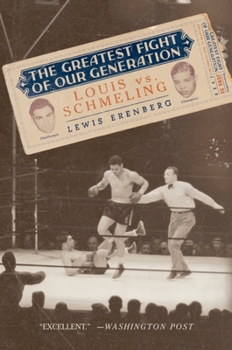The Greatest Fight of Our Generation: Louis Vs. Schmeling
Select Format
Select Condition 
Book Overview
Held on June 22, 1938, in Yankee Stadium, the second Louis-Schmeling fight sparked excitement around the globe. For all its length--the fight lasted but two minutes--it remains one of the most memorable events in boxing history and, indeed, one of the most significant sporting events ever. In this superb account, Lewis A. Erenberg offers a vivid portrait of Joe Louis, Max Schmeling, their individual
careers, and their two epic fights, shedding...
Format:Paperback
Language:English
ISBN:0195319990
ISBN13:9780195319996
Release Date:March 2007
Publisher:Oxford University Press
Length:288 Pages
Weight:0.95 lbs.
Dimensions:0.8" x 6.3" x 9.3"
Customer Reviews
2 ratings
Much, Much More than a Boxing Match
Published by Thriftbooks.com User , 16 years ago
This is one of those rare books bought for one reason and then one discovers later that there are larger reasons that entirely eclipse the original ones. To my great surprise and delight, it turns out that this book is as much about the international politics of race and ideology as it was about pugilism. Thus this is not just a report on a one-round boxing match heard around the world, whose outcome in any case is well known by most even before reading the book: Louis beat Max Schmeling with such a vicious attack that it broke several ribs and had many observers thinking that Joe Louis Barrow must have been a man possessed by demons. No, it is not a story just about that one-man, two-minute demolition squad, but about the state of the world as seen through the eyes of a skilled biographer of sports history. And about his views of what the fight meant to two competing societies. The stage for this, the second of the two fights between two "intellectually challenged" protagonists, could not have been more pregnant with meaning or more heavily imbued with dramatic significance. At the time the world community was deep in the throes of an international depression, in which images of male impotence abounded. Boxing loomed large as a surrogate to fill the gap of male lost self-esteem and as a "stand-in" for national virility among men with bruised, diminished and weakened egos. Thus the gladiators in the ring of Madison Square Garden on the night of June 22, 1938, were part of the global pre-fight between German Nazism and American democracy. For the multitudes on both sides of the Atlantic with lost jobs, and lost self-esteem, boxing: male power, mano-y-mano, framed an essential aspect of the national identity. Nazi Germany and "democratic" America became engulfed in, and swept up by the emotional hysteria of the Max Schmeling-Joe Louis fight. To both nations it was not just a defining moment in history, but also a showcase of the defining qualities of their respective political systems: their ideologies, their ways of life, and the meaning of boxing to their respective societies. In short, the fight took on a distinctive life of it's own. It was a "hyper reality" in which both fighters had a lot to prove. Even as a winner, who was "on the down side of" a career that included having won the world Champion in 1930 while still being "counted out" on his back, Schmeling, as a winner of the first fight, still had as much to prove as Louis did as a loser: Schmeling had to prove that his win over Louis and his earlier Championship belt were not flukes. Louis had to prove that they were. As far as German domestic politics were concerned the stakes also could not have been higher. At the 1936 Munich Olympics, Jessie Owens, another Black American, had severed the proverbial racist limb Hitler had so boastfully but precariously "walked out on." Owens had single-handedly embarrassed Hitler's claims of Aryan racial superiority by winning four gold medal
A great read, and an insightful approach
Published by Thriftbooks.com User , 18 years ago
Having been a fight fan since a small boy, I was looking forward to this book for the insight into the 2 most admired heavyweights of their age. But I got so much more. Erenberg succeeds in bringing to life the problems created by the segregation and dehumanisation of the African American in the 1930's, as well as the already well trodden theme of Aryan supremacy in Nazi Germany. Both these men, from humble beginnings, rose to fame quickly. They both became fierce rivals, and both quickly realised how they were being used as symbols of national pride. They met each other twice, and honours were even, but the most striking part of this book is how the author is able to bring to life how events on the world stage propelled them in such opposite directions, and also how life after the war sent them careering to the opposite end of the scale - Louis victorious yet penniless and dying in poverty, Schmeling the defeated yet living a life of privilege and great wealth. Although they were fierce rivals, they later became good friends, realising that they were in fact fighting for the same ideals, not what their respective governments were telling them. I recommend this book to anyone who is studying the noble art of pugilism, modern history or indeed civil rights. The research is meticulous, and the material is presented without overdue bias to either side, a considerable feat.





